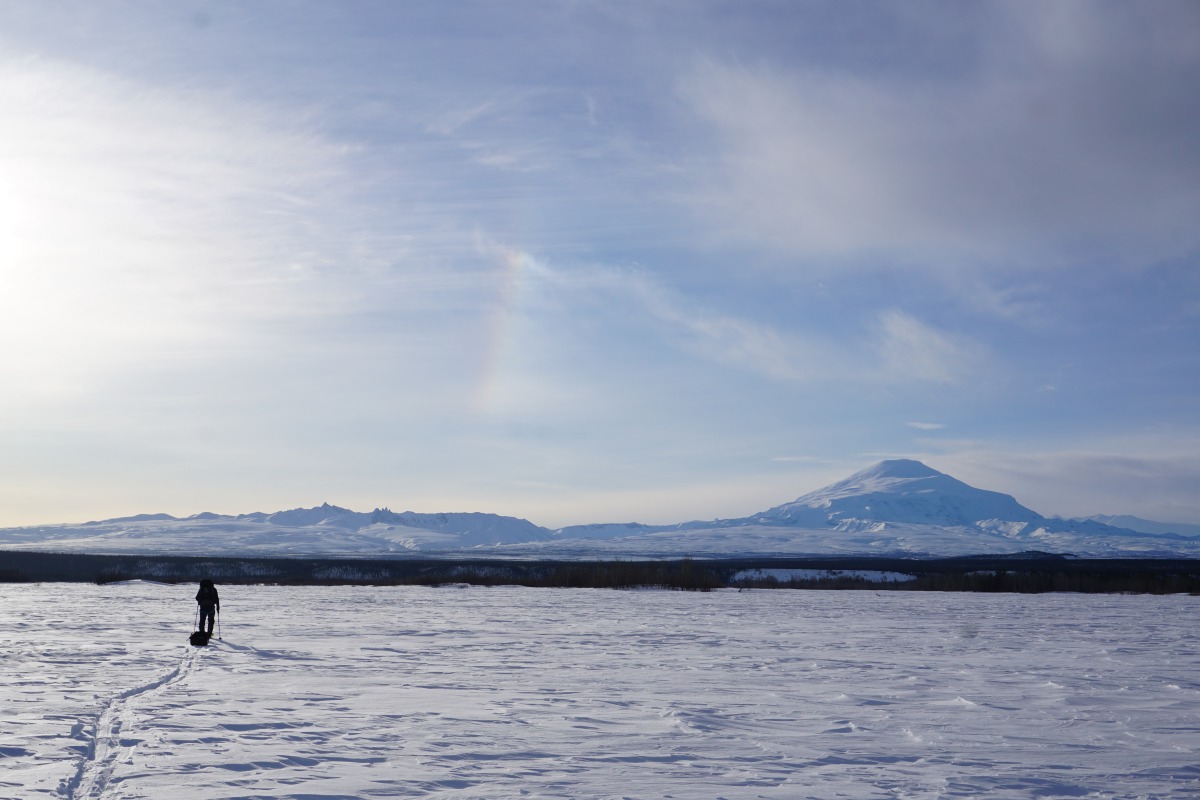
Sean starts the trip from the Chistochina River, Sanford towering in the background.
In March 2022, my brother Sean and I successfully climbed Mount Sanford (16,237′) in the Wrangell Mountain Range, Alaska. Starting from the nearest road outside Glenallen, we traveled 82 miles and 15,000 vertical feet in 3 ½ days, summited in -55° weather, and skied 12,000′ continuous feet directly off the summit.
The idea of climbing Sanford was inspired mainly by Luc Mehl’s attempt in 2011, where his team turned around at 15,000′ as they were running out of daylight. He ended up coming back later and summited with snowmachines.
Lacking snowmachines and not wanting to buy a plane ticket, we decided a human-powered accent was in our best interest. So we flew to Alaska from Colorado on March 10th and waited for 17 days before a good weather window presented itself. Lucky for us, our parents are still in Alaska, which provided great housing and food. Online work and venturing into the Chugach State Park also helped pass the time.

A screen grab from Google Earth specifying the general location of Mt. Sanford.
We were up early on March 24th to make the four-hour drive from Anchorage to the Chistochina River Trail Pull-off and started skinning by 9:00 am. The route begins by following the Chistochina river for two miles until it merges with the Copper River. This section is the primary reason for making this Trip in March (as we learned on our return, the warmer temps melted out our original path). We were concerned that crossing the Copper might be tricky, but it turned out to not be an issue on the way out. Both rivers were still completely frozen over. We then followed the Copper upstream for a mile before turning onto Boulder Creek for the next 25 miles.
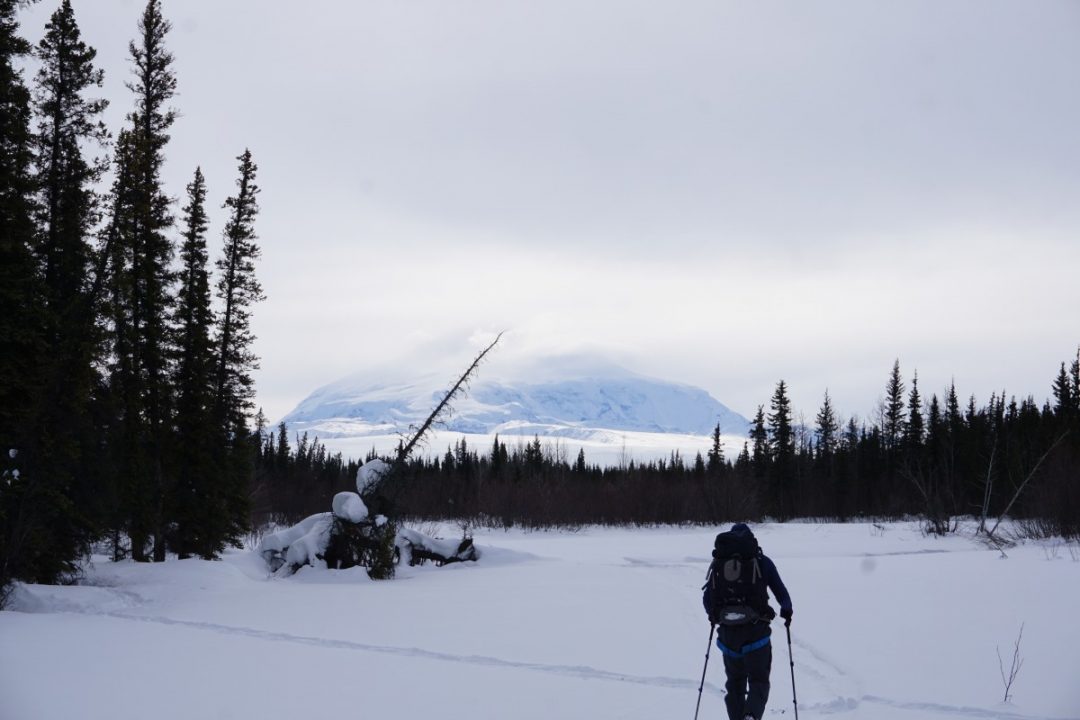
Sean starting up the never-ending Boulder Creek with Sanford looming in the background.
The approach up Boulder Creek is long, flat, and never-ending. We were fortunate to find an old snowmachine track out of the parking lot that continued up the Boulder Creek drainage (apparently, this is a common area for trapping in the winter). Deep snow covered the creek, and I don’t think we would have made it very far without the firm snowmachine track to follow. We traveled 19 miles on Day 1. The mountain still looked far away.

Sanford from camp on the first night.
Day 2 started by grinding out another 6 miles up Boulder Creek until it merges with the Sheep Creek drainage. Finally, we arrived at the base of the mountain! We trend right and gradually gain elevation until we reach a large plateau at 5000′, the landing strip and starting point for most expeditions. Here we ditched sleds and shouldered packs for the ascent to high camp.
We weave through the moraine and onto the Sheep glacier at 6000′. There are some large cracks on the lower glacier between 7,000′ and 8,500′, but they are to spot and avoid. Snow bridges are bombproof this time of year, and we decided to not rope up for any part of the glacier. Our goal was to make high camp near 10,000′, but by 7:30 pm, we ran out of daylight and stopped at 9,000′. The ambient air temperature dropped to -15° before sunset.

Crevasse Field at 8000’. Avoided on climbers right.

We Made Camp at the Top of this ridge at 9000’.
7:00 am start the following day. Up to this point, the upper mountain had been hidden behind a gentle roll near 10,500′. We eventually reached it and had our first good look at the summit and a confidence boost that we just might reach it. Our progress came at the price of losing our wind protection—which was blowing at a consistent 25 miles per hour with some gusts hitting mid-30s.
A mile or two took us to the base of what resembled another mountain sitting on top of the one we had just climbed. Here the route steepens again, but it never exceeds 35 degrees, and we have no trouble skinning.
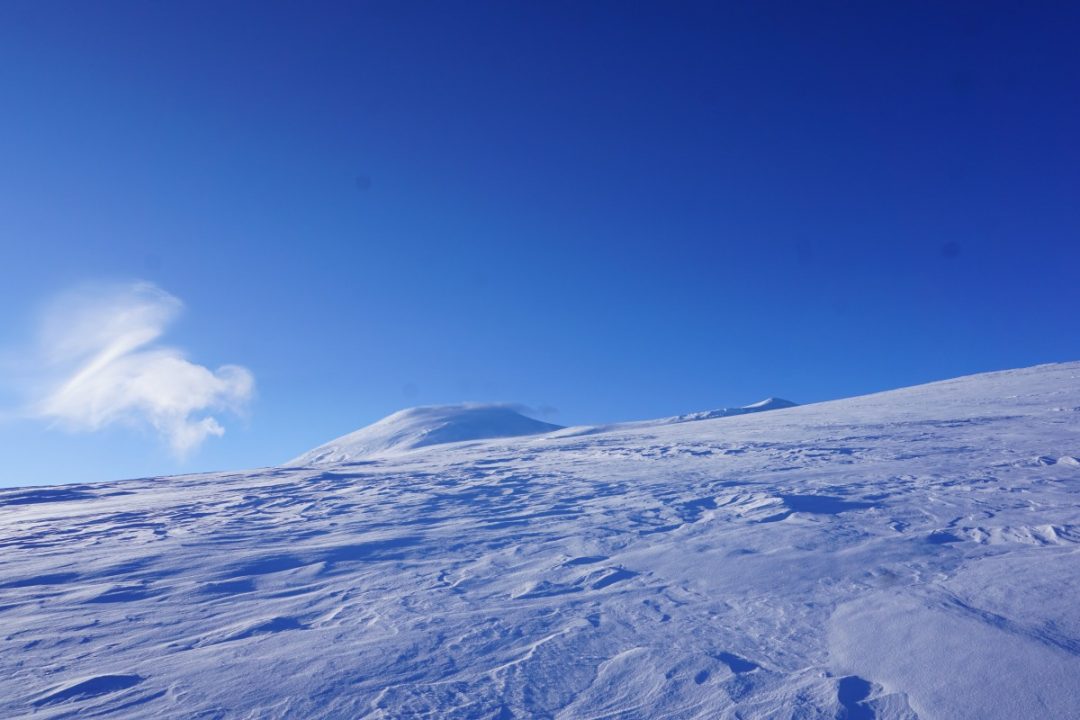
The summit finally in sight.
We put our heads down and grind for another few hours; It was too cold to stop for long. At 15,000′, we walk into a cloud hanging around the summit, but the sun is trying hard to break through and gives everything an odd yellow and orange tint that makes it feel like we are climbing on Mars. The wind picks up to at least 35 mph and bites at our covered faces.
Around 16,000′ a monster crevasse marks we are near the top. A gentle slope leads another quarter mile to the summit. Finally, at 4:55 pm, just 5 minutes before our agreed-upon turnaround time, we were standing at 16,237′ on the summit of Mount Sanford. The thermometer says it is -25 degrees out; combined with 35+ mph wind, the wind chill is deep into the -50s. Mountain Forecast said -55 Fahrenheit.

Sean high on the mountain, with most of our route in the background.
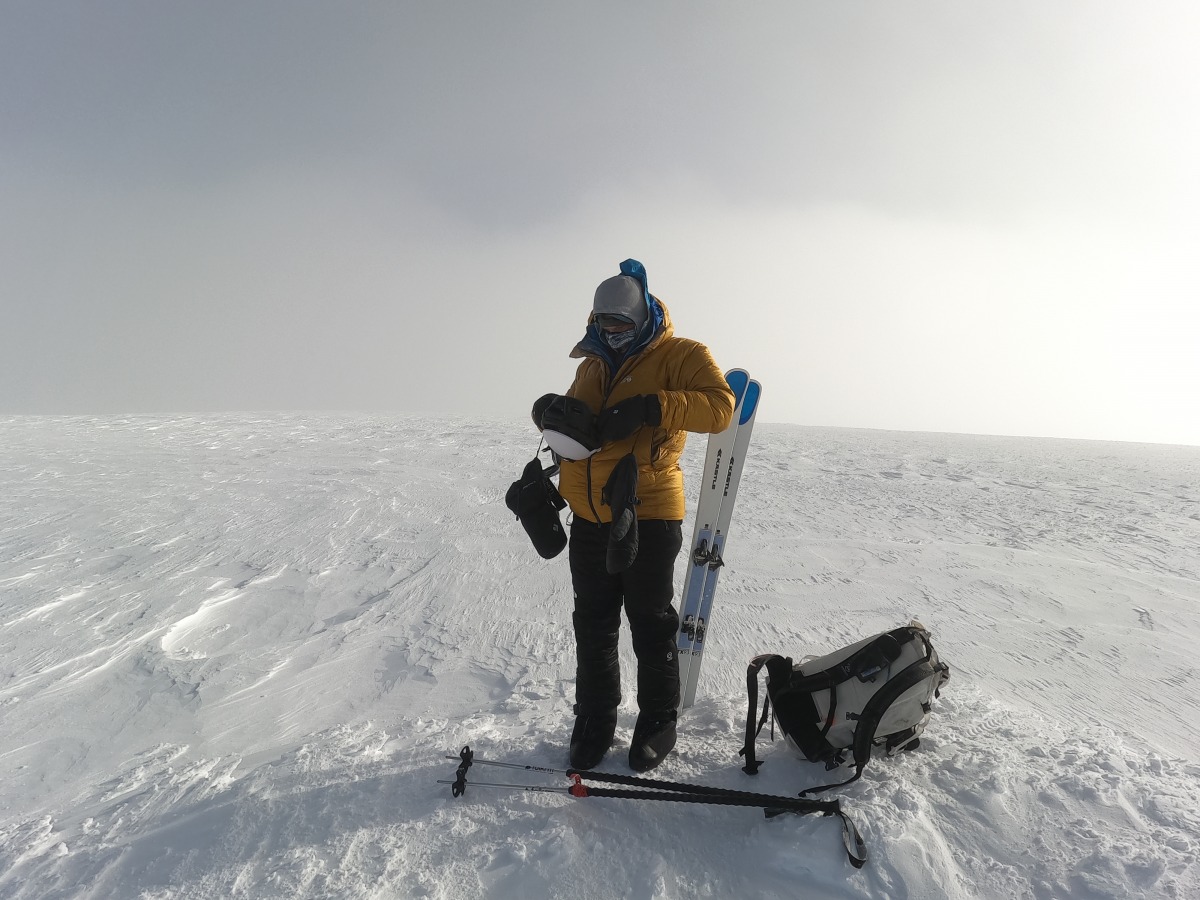
Ben bundled up on the summit of Mount Sanford—looking like the Stay Puff Marshmallow Man.
We didn’t stay long. Ten minutes to rip skins, mess with boots, add some layers and click in. The top 2000′ is sculpted by wind, and we ski carefully, avoiding the patches of ice and dropping through the clouds. We followed what remains of our skin track and flags. Around 12,000′, we survival skied over what seemed like an ice rink, but then the snow quality improved, and we descended quickly into the thicker air and back to camp. I look at my watch; it took us about 10 hours to climb 7,500′ and just 1 hour and 10 minutes to descend.
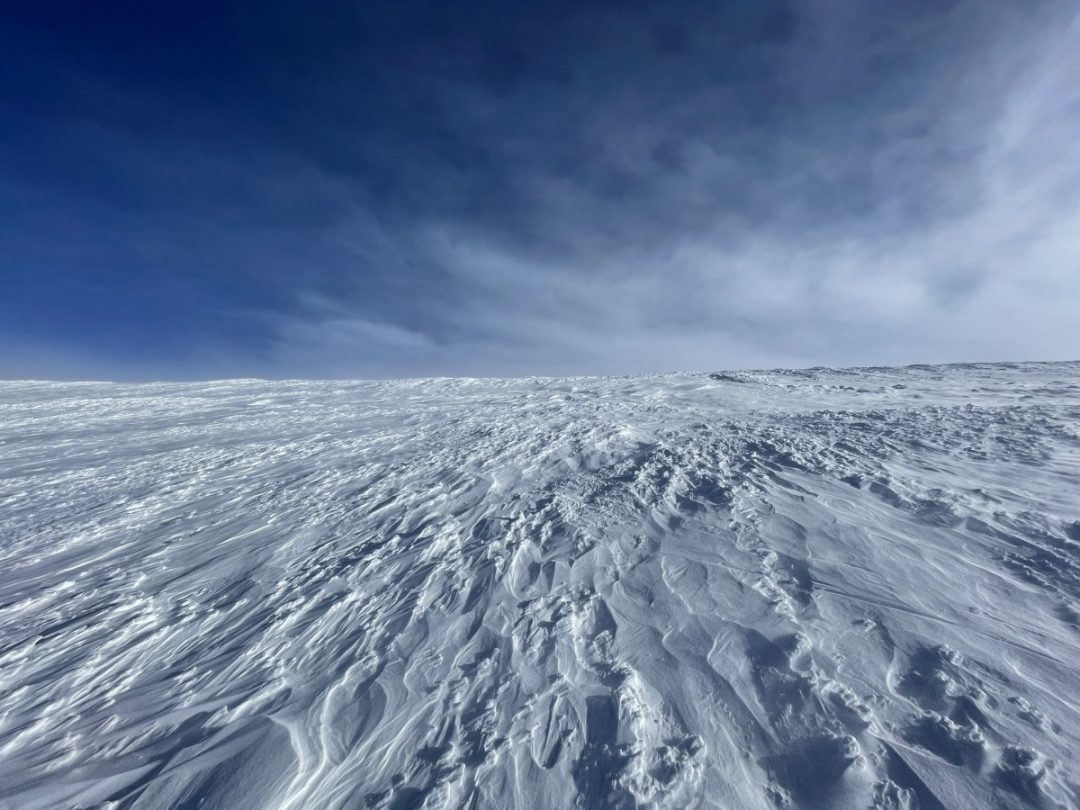
No pow turns were had, especially around 14,000.’
We quickly packed up camp and drop another 6000′ to our sleds. The flat light and heavy packs make skiing through the crevasse field tricky, but we are off the glacier in less than an hour. Packs go into the sleds, and we push a few more miles down to Boulder Creek to get to some flowing water.
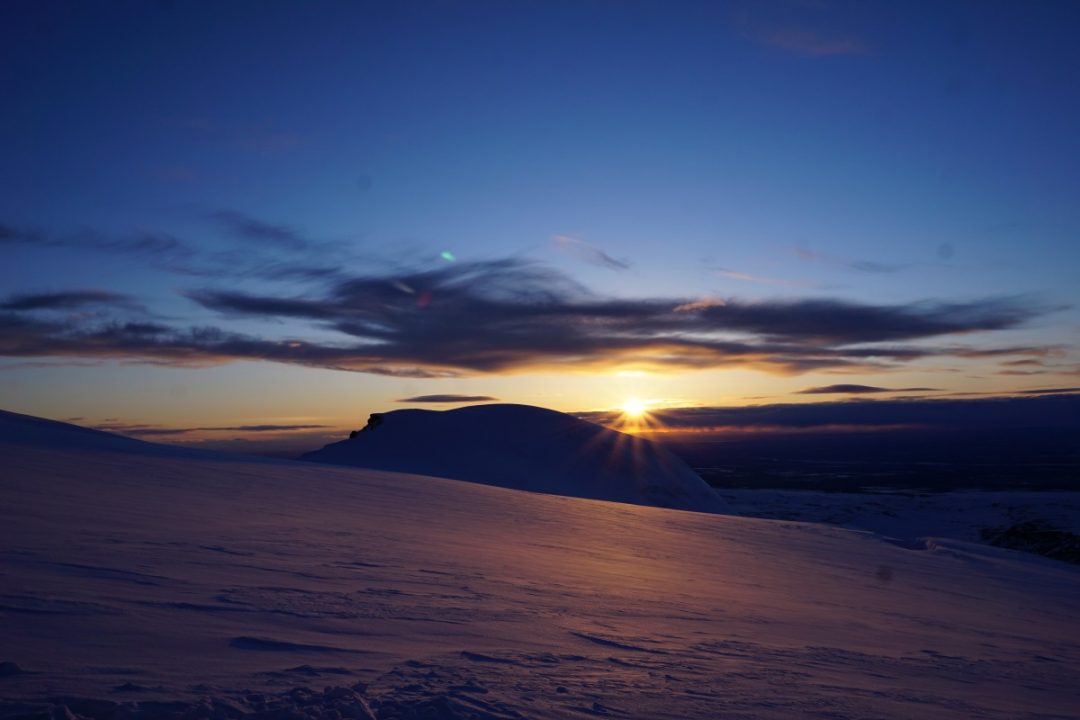
Sunset from high camp before our summit bid.
Fortunately, the 26 miles back to the car the next day was not quite as flat as we remembered on the way in, and we made it back with daylight to spare. Beta is relatively limited on Alaskan peaks like Sanford, but from what we could find, the only prior accents from the road were Bradford Washburn in 1938 and Dave Johnson solo in 1984 over 16 days. And at 19, I think Ben is the youngest to the summit and ski off the top, but that’s hard to say. This Trip was truly inspiring yet very physically demanding, which is the price you pay for a purist ascent of this Alaskan giant.
Ben is a Biomechanical Engineering major in college. In his fleeting spare time, he loves being in the outdoors, especially climbing and skiing peaks. he’s originally from I grew up in Eagle River, Alaska peak-bagging with my family in the Chugach. While attending school in Colorado he began skiing the 14ers. And like those things go, it’s a project.
